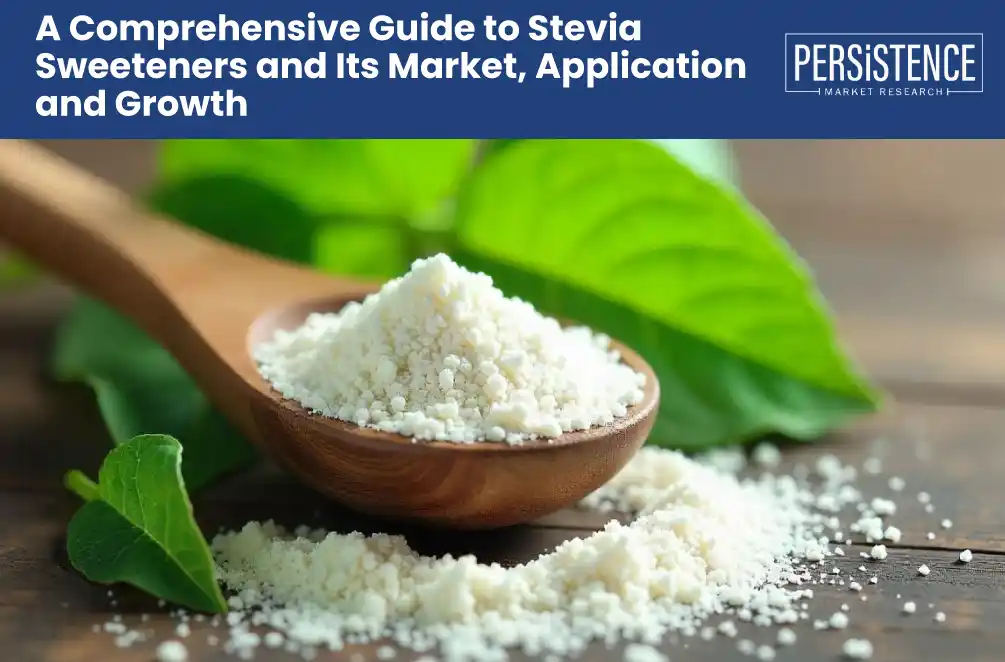- Blog
- Stevia Sweeteners Market Guide
A Comprehensive Guide to Stevia Sweeteners and Its Market, Application and Growth
Published On : 17 Jul 2025
What are stevia sweeteners, and what makes them so popular?
Stevia sweeteners are natural, zero-calorie sugar alternatives derived from the leaves of the stevia rebaudiana plant, native to South America. These sweeteners contain compounds known as steviol glycosides, mainly stevioside and rebaudioside A (Reb A), which are up to 400 times sweeter than sugar. Unlike artificial sweeteners, stevia is plant-based and aligns well with the growing consumer demand for clean-label, natural ingredients. It's also heat-stable and suitable for cooking and baking, making it a versatile option in the food and beverage industry.
In recent years, the global stevia sweeteners market has witnessed a significant growth due to increasing concerns about obesity, diabetes, and overall sugar consumption. As health-conscious consumers actively seek low-calorie, low-carb alternatives, stevia has emerged as a preferred choice. It’s especially popular among those following keto, diabetic-friendly, and low-sugar diets. The absence of calories and its plant-based origin make it a strong candidate in a market dominated by artificial sweeteners like aspartame and sucralose.

What are the different forms of stevia available?
Stevia is sold in several forms - powder, liquid, and granulated extracts. Powdered stevia currently dominates the market due to its long shelf life, ease of use, and cost-effectiveness. It's widely used in baked goods, dry beverage mixes, and dietary supplements.
Liquid stevia, on the other hand, is gaining momentum for its rapid solubility and ease of application in ready-to-drink beverages, sauces, and syrups.
How are companies differentiating themselves in the stevia sweetener market?
Manufacturers are focusing on product innovation, sustainability, and improved taste profiles. One major advancement has been the use of fermentation and enzymatic conversion to produce high-purity glycosides like Reb M and Reb D. These compounds provide a more sugar-like sweetness without the lingering bitterness traditionally associated with stevia.
Companies are also introducing solutions to improve solubility, especially for liquid applications. Products like Sweegen’s ‘Bestevia LQ’ and PureCircle’s ‘Clean Taste Solubility Solution’ address this need. Sustainability and traceability are increasingly important, with firms investing in vertically integrated supply chains and environmentally responsible farming practices. PureCircle has built partnerships with thousands of farmers to ensure ethical sourcing, and Splenda now operates a stevia farm in the United States.
What are the primary applications of stevia?
Stevia is used across a wide range of industries, with the food and beverage sector being the largest. It is especially prominent in soft drinks, flavored waters, juices, and dairy-based beverages. As consumers seek healthier alternatives, more brands are replacing sugar or artificial sweeteners with stevia in their formulations.
Beyond beverages, stevia is used in baked goods, snack bars, yogurts, sauces, and salad dressings. The pharmaceutical and nutraceutical sectors also employ stevia in sugar-free medications, protein powders, and dietary supplements. In personal care, it’s used in oral hygiene products due to its non-carcinogenic properties. As taste technologies improve, stevia is expected to be included in even more applications, including functional foods and plant-based products.
What are the key trends and challenges in the stevia market?
Key market trends include the rise of clean-label products, consumer preference for plant-based ingredients, and increasing regulatory support for sugar reduction. Governments in several countries have imposed sugar taxes, further encouraging manufacturers to reformulate products with alternatives like stevia. Technological advancements, particularly in the development of better-tasting and more soluble stevia extracts, are also shaping the market.
However, the industry faces challenges such as taste concerns, especially bitterness and licorice-like aftertaste in lower-purity products. There are also regulatory hurdles, as not all forms of stevia are approved in every country. The cost of production can be high, particularly for fermented stevia, and competition from other natural sweeteners like monk fruit and allulose adds pressure to innovate.
What does the future hold for the stevia sweeteners market?
With growing awareness about health and wellness, and regulatory efforts to reduce sugar consumption globally, stevia is well-positioned as a leading natural sweetener. Market forecasts suggest continued double-digit growth over the next decade, driven by increased demand in both emerging and developed markets.
Innovation will be key to future success. Companies that invest in advanced glycoside development, fermentation technology, and sustainable sourcing will have a competitive advantage. Strategic partnerships between ingredient suppliers, flavor houses, and major food and beverage brands will further accelerate Stevia’s integration into mainstream products. As taste and affordability improve, Stevia is poised to become a staple ingredient in the future of healthier food and beverage options.
Industry Report

Request Report Sample
Your privacy is important to us; your data is secure
Contact Us
Latest Reports
-
Piezoresistive Pressure Sensor Market by Sensor Type (Absolute, Gauge, Differential, Sealed), Pressure Range (Low Pressure (<10 kPa), Medium Pressure (10 kPa – 1000 kPa), High Pressure (>1000 kPa)), End-Use Industry (Automotive & Transportation, Industrial Manufacturing, Healthcare, Aerospace & Defense, Electronics) and Regional Analysis for 2026-2033
-
Aquarium Accessories Market by Product Type (Filtration Items, Lights & Hoods, Temperature Control Systems, Others), End-User (Residential, Commercial), Distribution Channel (Online, Offline), and Regional Analysis for 2026-2033
-
Oxygen Therapy Market by Product Type (Compressed Oxygen, Concentrated Oxygen, Liquid Oxygen), Disease (Respiratory Disorder, Cardiovascular Disease, Sleep Apnea, Pneumonia), End-User (Hospitals, Home Healthcare, Clinics), and Regional Analysis for 2026-2033
-
Air Curtains Market by Product Type (Non‑Recirculating, Recirculating, Heated, Others), Airflow Capacity (Up to 500 m³/h, 500–1000 m³/h, 1000–1500 m³/h, Above 1500 m³/h), Application (Commercial, Industrial, Residential, Others), and Regional Analysis for 2026–2033
-
Personalized Stationery Market by Product type (Storage & Filling Products, Paper-Based Products, Drawing & Writing Instruments, Accessories, Bags, Others), Application (Educational Institutes, Corporate Offices, Personal Use, Hospitals, Others), and Regional Analysis for 2026–2033
